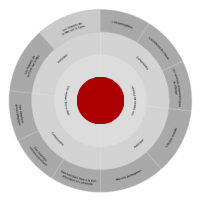ANNUAL SURVEY PAPER
Edward LORENZ (Meteorologist), 1972
INTRODUCTION
This annual digital publication from the Royal Institute for Strategic Studies (IRES) aims to inform public and private decision-makers of the main emerging trends that need to be kept in mind when drawing up any short- and medium-term strategy or action plan.
It comes in two formats:
- A printable document, downloadable above.
- A series of short articles, one per subject, distributed along the IRES reading grid, and accessible by category via the horizontal menu above.
OBJECTIVE
Decision-makers need to adapt to new realities arising at a faster pace than ever before. Since the pandemic, there has been a heightened interest, across all sectors, in identifying emerging trends, understanding how to prepare for them and dealing with the present better equipped.
To minimize the surprises in the short and medium term, agents of change (decision-makers, operators, stakeholders) need to raise their level of vigilance and extend it to all current emerging trends, which they can no longer ignore.
This digest of part of the Institute’s exploratory foresight survey aims, each year, to broaden and add to the major emerging trends observed over the last twenty years. Without claiming to be exhaustive, it targets a few trends in each of the five pillars that define the IRES reading grid, and highlights their impact on Morocco, its natural environment, its population, its various industries and businesses, and its future.
CURRENT EVOLUTIONS
The evolution of human beings and the societies they form
- Individuals: individualism, Alien Gen (digital natives and mutants).
- Human societies: decohesion, freedom/security balance, Liquid Society (disappearance of binary characterizations of individuals).
- Governance: democracy, collective intelligence, soft power.
Thus: the way people live, work and interact, from education and commerce to media, healthcare and government relations, has been revolutionized by digitalization. Digital platforms (Uber, Airbnb, Amazon) have transformed the economic landscape, creating new business models based on sharing and convenience (sharing economy, result economy). Over the past 20 years, China has become a major economic power, with considerable influence on the global economy and international politics.
The evolution of technologies as instruments of human action
- Increasingly electrified and digitalized technical devices.
- Biotechnologies modifying the human genome.
- Widespread integration of artificial intelligence.
- Next tech: future development of nuclear fusion, wider use of additive manufacturing, virtualization of human activities (metaverses, augmented reality, cyberprotection, etc.).
Thus : Artificial intelligence and robotic automation have begun to spread, from autonomous vehicles to personal virtual assistants and advanced manufacturing, influencing the future of work. The sequencing of the human genome, advances in gene therapy and biotechnology, coupled with the development of Artificial Intelligence in healthcare, are contributing to the emergence of more personalized and precise healthcare.
The evolution of civilizations and their interaction with Nature
- Anthropocene: civilization based on the exploitation and control of nature (essentially for economic purposes).
- Planetization: appropriation and use of the entire planet.
- Progressive reaching of planetary limits: alteration of the survival capacity of the human species on the planet.
Thus: In the wake of the climate crisis, an increasing number of governments and companies have embarked on initiatives to reduce carbon emissions and promote sustainable development and energy transition: renewable energies, circular economy, sustainable agricultural practices… Globalization is about to come to an end, giving way to a state of mundiality in which virtually any point on the planet would be accessible to any individual.
The broad outlines of this panorama will be supplemented each year by the identified emerging trends and presented in this new collection of IRES publications
CONCEPTUAL FRAMEWORK
IRES uses a conceptual framework to decipher current and future developments, based on five pillars: exponentiality, planetization, governance, humanity and nature. The various emerging trends identified throughout the survey and brought together in the Annual Survey Paper are distributed along these five pillars:
- Human-centric: all the evolutions and aspirations that are helping to reshape Humanity, in its uniqueness as well as in its sociability, in its relationship to machines, to work and to its living environment.
- Nature-centric: the search for a different relationship with the living world, for an economy that is more respectful of the planet and a lifestyle that is less consumer-oriented; the realization that we must now take care of nature and all living things.
- Exponentiality: all structural phenomena that are accelerating exponentially, such as communication technologies, digitalization, demographics, economic competition, financialization, social inequalities.
- Planetization: a new, disruptive stage of progress, during which a state of mundiality (post-globalization) coexists with a new awareness of the “living” quality of the planet, as a biosphere of which humans are only one component.
- Governance: all the processes involved in managing collective action, based on the orientation of stakeholders’ behavior (bottom-up), and the mobilization and motivation of “agents” (concerted action, soft power).
All of these items are displayed on a synthetic radar.
Sorted alphabetically within each pillar, these emergences aim to identify the most varied fields possible.
Each emergence is organized as follows:
- Pillar concerned
- Title
- Definition (a more concise definition can be found in the Glossary)
- Description of emergence and current situation
- Overview of the issue
- Consequences for Moroccan public and private decision-makers
Finally, while the pdf version offers a glossary at the end of the book, simply move your mouse over the underlined terms in the posts of the digital version to see the definition displayed.


